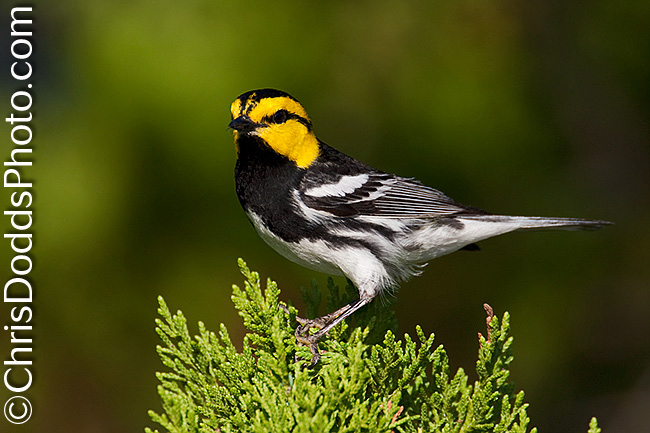 Golden-cheeked Warbler (male) Dendroica chrysoparia (Paruline à dos noir) Los Madrones Ranch (Texas Hill Country), Dripping Springs, Texas. Image Copyright ©Christopher Dodds www.chrisdoddsphoto.com All Rights Reserved. Canon EOS 1DMKIII, 500mm F4 IS, 2X II Tele-converter, Gitzo 1325 Tripod and Wimberley Head II. ISO 640, F8 1/800s Aperture Priority mode (-1/3 stop).
Golden-cheeked Warbler (male) Dendroica chrysoparia (Paruline à dos noir) Los Madrones Ranch (Texas Hill Country), Dripping Springs, Texas. Image Copyright ©Christopher Dodds www.chrisdoddsphoto.com All Rights Reserved. Canon EOS 1DMKIII, 500mm F4 IS, 2X II Tele-converter, Gitzo 1325 Tripod and Wimberley Head II. ISO 640, F8 1/800s Aperture Priority mode (-1/3 stop).
On Tuesday, April 21 at 03:30 we got an early start and drove the 675 miles to Los Madrones Ranch in Dripping Springs, Texas. After avoiding a collision with a rogue wheel early on, the drive was relatively uneventful. Micheal Murphy greeted us around four o'clock, and showed us around the gorgeous Casita that we will call home until Friday, April 24. We spent the last hours of light photographing Black-Crested Titmouse, Carolina Chickadee and House Finch in prime breeding plumage. We also had some great looks at five great Sparrows (more to follow in another post).
The highlight of the trip so far was when Greg W. Lasley www.greglasley.com (Texas' premier birder) arrived and took us to photograph the endangered Golden-Cheeked Warbler. It was an amazingly productive and satisfying morning.
Special thanks to Greg W. Lasley and to Michael & Julie Murphy @ Los Madrones Ranch. If you are planning a trip to Texas, be sure to look them up www.losmadrones.com (512) 264-1741
The Golden-cheeked Warbler Dendroica chrysoparia Paruline à dos noir is an endangered species of bird that breeds in Central Texas, from Palo Pinto County southwestward along the eastern and southern edge of the Edwards Plateau to Kinney County. The Golden-cheeked Warbler is the only bird species with a breeding range confined to Texas. Golden-cheeked warblers nest in ashe juniper and live oak trees in ravines and canyons. They use bark and spider webs to build their nests. Females lay three to four eggs. Warblers eat insects and spiders and the adult warbler can reach a length of 4.5 inches. They winter in southern Mexico (Chiapas), Guatemala, Honduras, and Nicaragua. The warbler is endangered as many juniper and oak woodlands have been cleared to build houses, roads, and stores or to grow crops or grass for livestock. Other woodlands were flooded when large lakes were constructed.